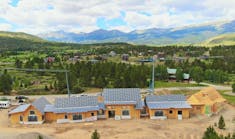Did you know that there are basically two types of sand? First, there’s water-swept sand. This is the sand you find near rivers, lakes, and beaches. And there’s wind-swept sand. You’ll find wind-swept sand in deserts. For years, water-swept sand has been used to make concrete because of its grittiness. Wind-swept sand has always been too smooth to be used, so it’s pretty much useless for construction purposes.
The problem is that we’re running out of the sand we need to make concrete. A solution may have been discovered just in time by a group of post-graduate students from Imperial College London. The quartet developed a material they call “Finite.”
According to its website Finite, “a newly developed material composite, opens new opportunities to make use of desert sand and other abundant fine powders that traditionally have no use. Finite can form these fine powders into structures that have the same strength as traditional housing bricks and residential concrete. Finite is environmentally friendly, with less than half the carbon footprint of concrete. Most impressively, thanks to its material properties, Finite can be remolded for multiple lifecycle uses. Finite is versatile and able to perform many functions and build many intricate forms and finishes. The team is currently developing Finite to bring it to market with some exciting initial opportunities.”
Apparently, Finite has a secret binding ingredient that makes it more environmentally friendly. The binding ingredient is used instead of typical cement paste. That paste accounts for approximately 5% of the global CO2 production. It’s such a massive amount that there are multiple efforts being made to try to reduce it. Finite has less than half of the carbon footprint of typical cement paste and it is completely reusable and recyclable.
Reusable and recyclable is a good thing considering the world is starting to run out of water-swept sand.





